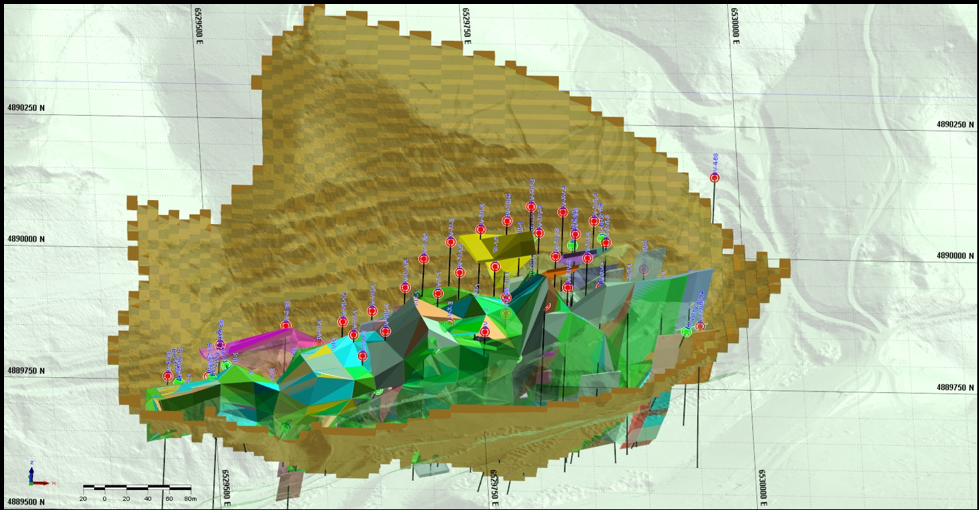Veovaca Mineral Resource
Bosnian Maiden Resource Estimates
8 June 2019
Drilling at Veovaca has added gold and silver to the entirety of the Mineral Resource estimate and increased the Indicated Resource Category to 71%. The Veovaca Mineral Resource begins at surface and currently extends to depths of 200 m.
VEOVACA DRILLING AND SAMPLING
A total of 84 diamond drill holes (51 historical drill holes and 33 drill holes from Adriatic Metals’ 2017 (16 holes) and 2019 (17 holes) for 11,745 m define the Veovaca deposit, of which 83 assayed drill holes intersect the interpreted mineralisation zones. The Veovaca deposit was sampled using diamond drill holes at nominal 20-25 m spacing on 20-25 m spaced northwest-southeast oriented sections. All of the historical holes were vertical. Holes drilled by Adriatic Metals were generally angled 60° to 70° towards the north-northwest with dip angles set to optimally intersect the mineralised bodies. Diamond core has been sampled for assay; whole core for the historical drilling and half core (HQ) for the recent drilling. Recent assays were undertaken by ALS and SGS, both located in Bor, Serbia. Further information is provided in the Veovaca JORC Table 1.
VEOVACA GEOLOGY AND MINERALISATION
The Veovaca deposit lies in the core of an interpreted synform having a sub-vertical to very steeply dipping (to the north-northeast) axial plane that strikes east-northeast to west-southwest (Figure 1). The barren surrounding sediments provide a marked contrast to the brecciated and mineralised core of the synform. Three typical cross-sections are shown in the following figures (Figure 2 to 4). Figure 2 is a section through the western part of the deposit where high-grade mineralisation extends from the old pit floor to depths of about 50 m. Figure 3 is a section through the middle part of the deposit where high-grade mineralisation extends from the old pit floor to depths of 115 m, and Figure 4 is a section through the eastern part of the deposit where high-grade mineralisation starts some 100 m beneath ground surface extending to depths of 190 m. Mineralisation remains open to the east-northeast.
Figure 1: Simplified Veovaca Geology with Drilling (2019 in red)
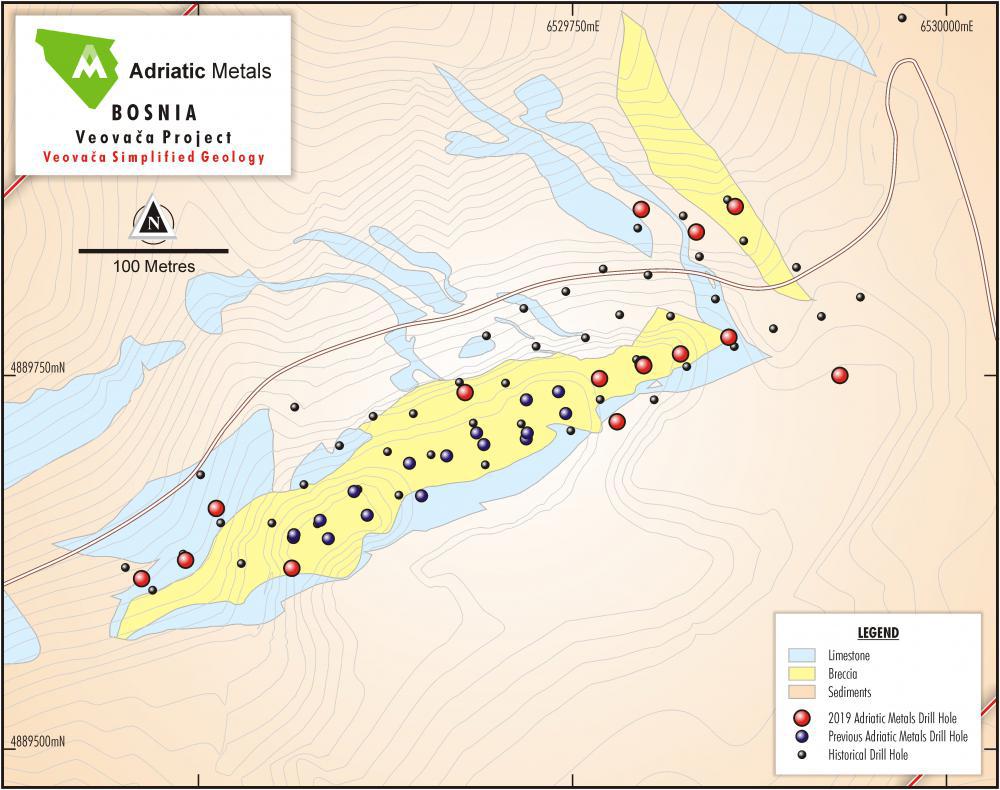
The polymetallic mineralisation is associated with Middle Triassic rining. The mineralogical assemblage of the ore is relatively simple, it typically consists of pyrite, sphalerite, galena (argentiferous), barite and chalcopyrite with minor gold, tetrahedrite, boulangerite and bournonite. Sphalerite is particularly light in colour suggesting that it has low iron content.
VEOVACA MODELLING AND GRADE INTERPOLATION
The main geological units that control polymetallic mineralisation were interpreted using geological logging and structural codes, and used to control the interpretation of all mineralised bodies. The interpreted geological units were not wireframed, but they were used as a background as mineralised lenses were interpreted. Separate mineralisation outlines for each element were generated interactively for 18 NNE-SSW orientated cross-sections using individual cut-off grades that were established by the geostatistical analysis.
Mineralisation outlines were developed separately for each element using individual cut-off grades that were established using geostatistical analysis. Five elements were modelled; Zn, Pb, BaSO5, Au and Ag and three of them (BaSO5, Ag and Au) had two grade domains interpreted and modelled.
Figure 2: Geological Section - West
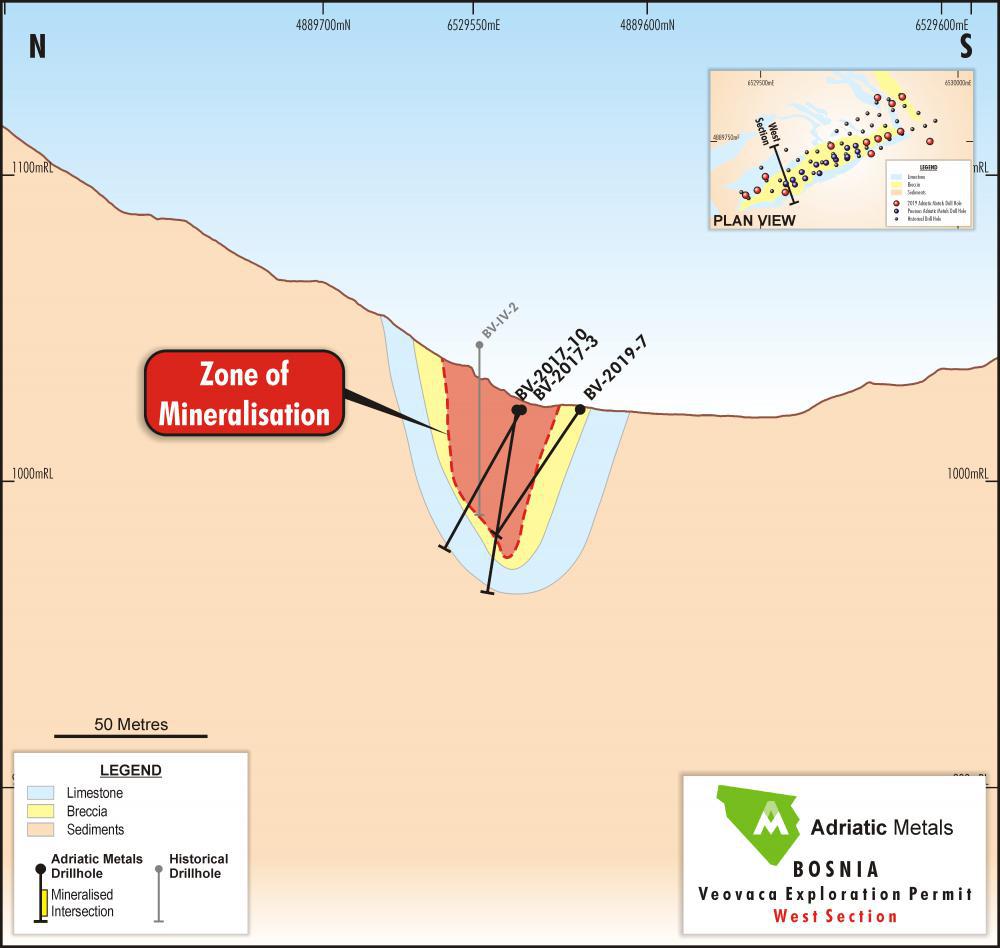
Figure 3: Geological Section - Central
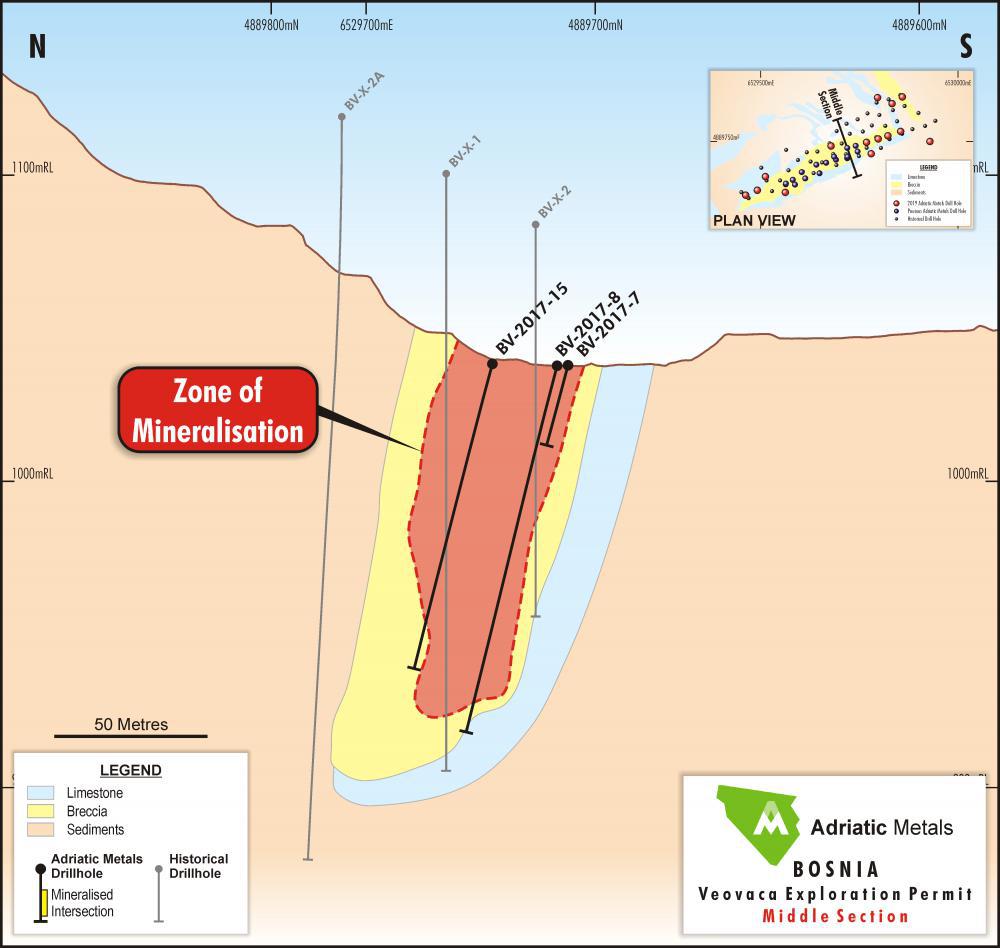
Figure 4: Geological Section - East
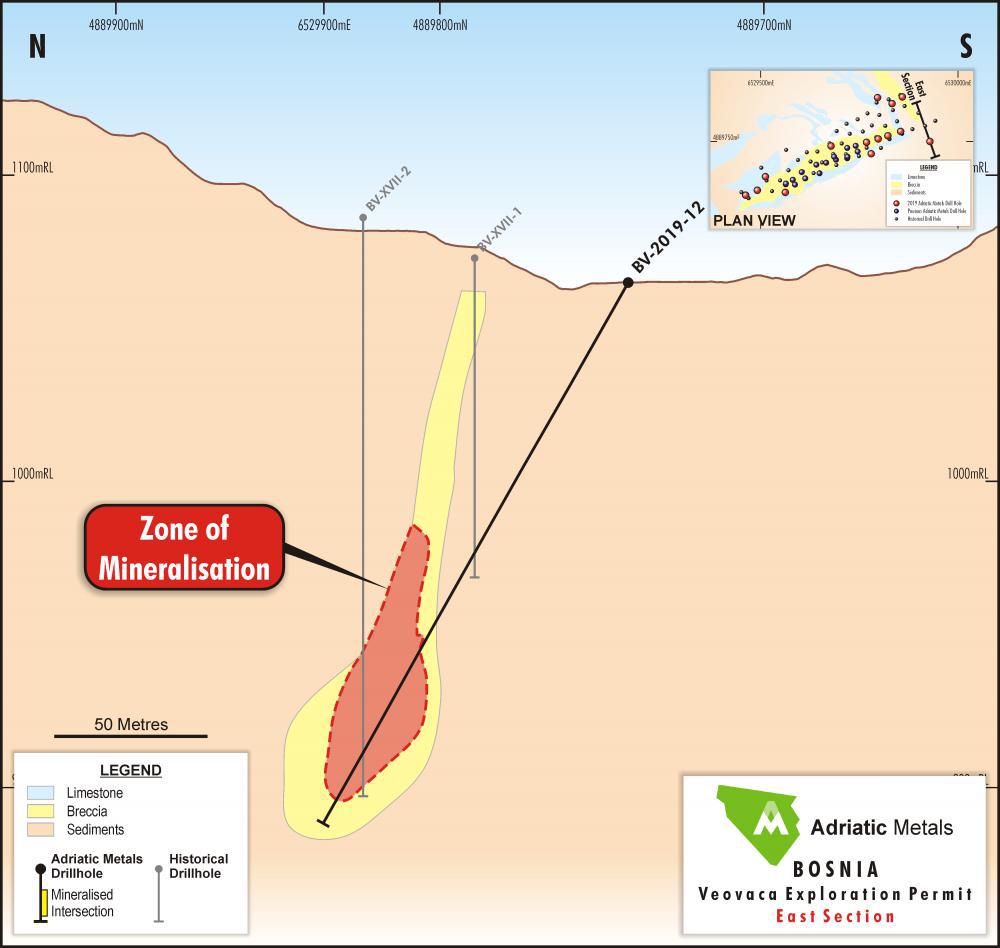
The interpreted high-grade domains were nested within the corresponding low-grade domains. All interpreted strings were cross-validated to make sure that interpretation of all elements is consistent across all elements. Underground channel samples were also used to support the interpretation, but they were excluded from all subsequent modelling processes, and not included in the estimation dataset.
An example of an interpreted section is shown in Figure 5 (where green strings and left hatches on the drill holes represent lead grades, purple strings and right hatches represent zinc grades). Each element was interpreted in a similar way.
Figure 5: Cross section interpretation of Zn grades
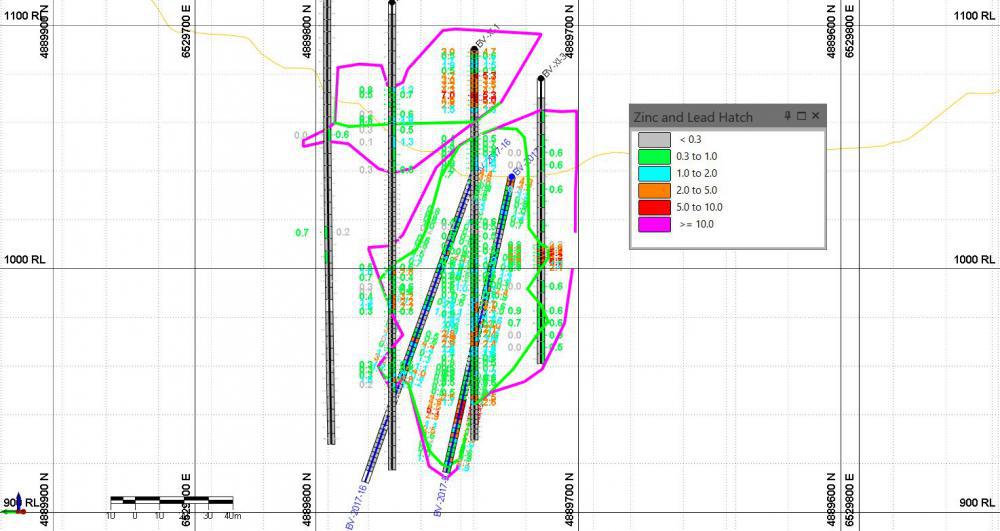
The interpreted strings were used to generate 3D ‘solid’ wireframes for each modelled element (Figure 6). Every cross section was displayed on the screen along with the closest interpreted section. If the corresponding envelope did not appear on the next cross section, the former was projected half way to the next section, where it was terminated. Every interpreted lode was wireframed separately and individually. All wireframe models were validated for closure and no overlapping triangles.
Figure 6: Wireframe models for Zinc - looking north
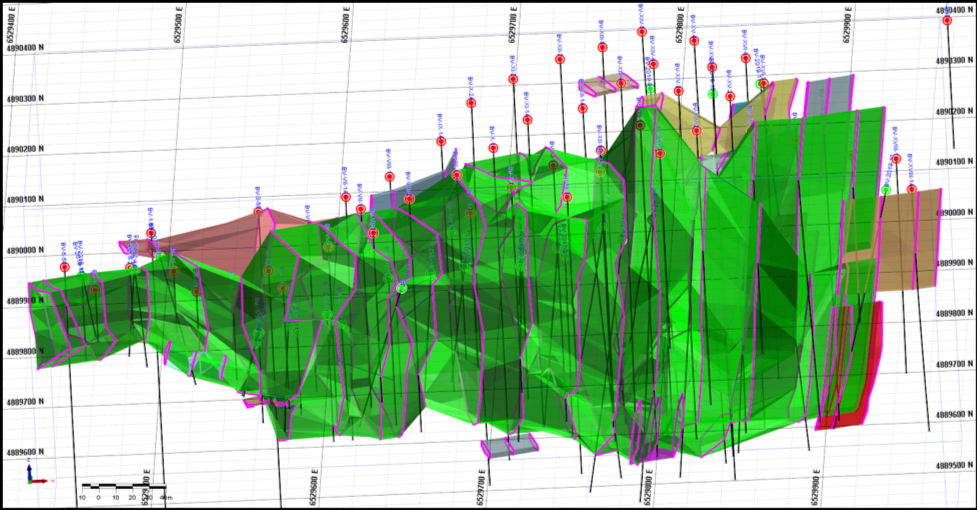
Once mineralisation for each element was interpreted and wireframed, classical statistical analysis was repeated for the samples within the interpreted envelopes to estimate the mixing effect of grade populations for each element, to estimate the necessity of separation of grade populations if more than one population was observed, to determine the appropriate down hole composite length and to determine the top-cut grades for each element for grade interpolation.
Geostatistical analysis generated a series of semivariograms that were used during Ordinary Kriging. The semivariogram ranges determined from the analysis contribute heavily to the determination of the search neighbourhood dimensions. All variograms were calculated and modelled for the composited sample file constrained by the corresponding mineralised envelopes for each element. Where low-grade and high-grade domains were modelled, samples were combined for both domains to ensure that the number of samples was sufficient for robust geostatistical analysis. It was found that absolute semivariograms were difficult to model, and therefore, relative semivariograms were modelled for Pb, Zn, Ag and BaSO4 grades. Absolute variograms were modelled for Au grades.
Density measurements were taken from core samples. A total number of 1,518 samples from 47 holes were analysed and the results used to determine the regression formulas for bulk density. The bulk density values were calculated for each model cell using a regression equation.
Eight empty block models were created within the closed wireframe models for the mineralised envelopes interpreted and modelled for each element and each grade domain (Zn, Pb, BaSO4 low-grade, BaSO4 high-grade, Au low-grade, Au high-grade, Ag low-grade and Ag high-grade). All high-grade domains were added on top of the low-grade domains to make sure that the model coding was correct. All eight block models were added together to a single model, and restricted with the topography surface.
Pb, Zn, BaSO4, Au and Ag grades were interpolated into the empty block model using the Ordinary Kriging (“OK”) method and a “parent block estimation” technique, i.e. all sub-cells within a parent cell were populated with the same grade. The OK process was performed at different search radii until all cells were interpolated. The search radii were determined by means of the evaluation of the semivariogram parameters, which determined the kriging weights to be applied to samples at specified distances. The blocks were estimated using only assay composites restricted by the wireframe models, and which belonged to a corresponding lens and corresponding domain. Block grades were validated both visually and statistically and all modelling was completed using Micromine software.
VEOVACA CLASSIFICATION AND REPORTING
Clause 20 of the JORC (2012) Code requires that all reports of Mineral Resources must have reasonable prospects for eventual economic extraction, regardless of the classification of the resource. The Veovaca deposit has reasonable prospects for eventual economic extraction on the following basis:
All mineralisation bodies are relatively close to the surface and exposed at the base of the existing pit and therefore potentially amenable to lower cost open pit mining,
Historical mineral processing and preliminary metallurgical test work confirm that the Veovaca mineralisation is amenable to flotation processes,
Preliminary metallurgical test work by WAI to produce a barite concentrate from Veovaca mineralisation using flotation methods has confirmed that a barite concentrate may meet API specifications.
The cut-off grade adopted for reporting (0.6% ZnEq) is considered reasonable given the Mineral Resource is likely to be exploited by open cut mining methods and processed using flotation techniques.
Preliminary open pit optimisation tests confirmed that the deposit has potentially positive net present value, and that almost the entire mineralised zone is potentially mineable using open pit methods under the given economic scenario and parameters. The optimisation study was for the sole purpose of providing information to Adriatic Metals about the mining potential of the deposit at this stage of evaluation only, and also to meet the clause 20 of the JORC Code. This study is conceptual in nature and does not represent any kind of Ore Reserve estimate. The generated ultimate undiscounted pit shell was 650 m long x 500 m wide and about 230 m deep (Figure 14).
The Veovaca Mineral Resource has been classified based on the guidelines specified in the JORC Code, and it is therefore suitable for public release. The classification level is based upon an assessment of geological understanding of the deposit, geological and mineralisation continuity, drill hole spacing, QC results, search and interpolation parameters and an analysis of available density information. The MRE is reported by classification in Table 2, Table above a cut-off grade of 0.6% zinc equivalent.
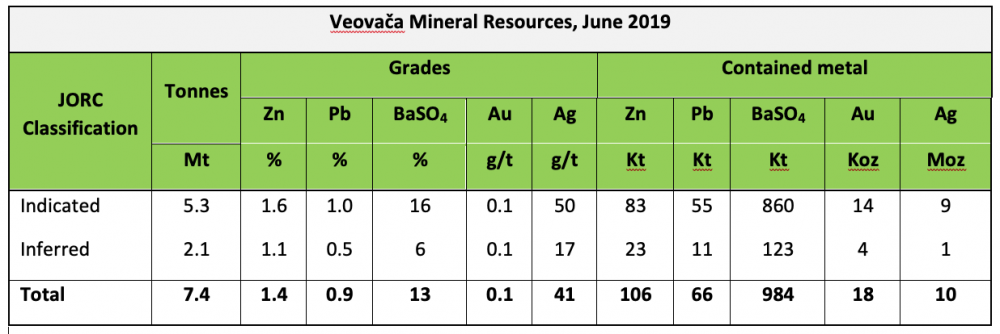
Notes:
- Mineral Resources are based on JORC Code definitions.
- A cut-off grade of 0.6% ZnEq has been applied.
- ZnEq was calculated using conversion factors of 0.80 for Pb, 0.08 for BaSO4, 1.80 for Au and 0.019 for Ag, and recoveries of 90% for all elements. Metal prices used were US$2,500/t for Zn, US$2,000/t for Pb, US$200/t for BaSO4, US$1,400/oz for Au and US$15/oz for Ag.
- The applied formula was: ZnEq = Zn% * 90% + 0.8* Pb% * 90% + 0.08* BaSO4% * 90% + 1.8* Au(g/t) * 90% + 0.019* Ag(g/t) * 90%.
- It is the opinion of Adriatic Metals and the Competent Persons that all elements and products included in the metal equivalent formula have a reasonable potential to be recovered and sold.
- A bulk density was calculated for each model cell using regression formula BD = 2.70855 + BaSO4* 0.01487 + Pb * 0.03311 + Zn * 0.03493.
- Rows and columns may not add up exactly due to rounding.
Figure 7: Ultimate undiscounted pit shell (looking north)
